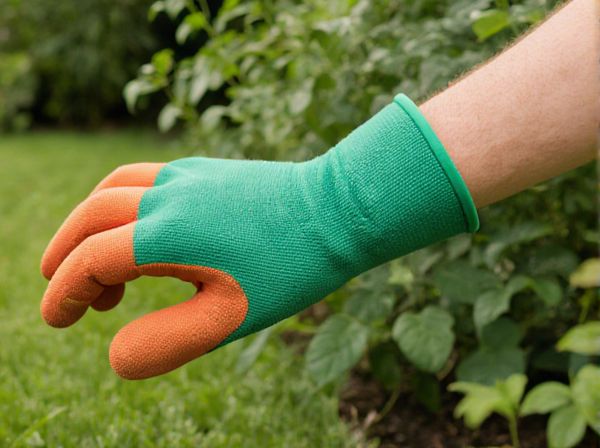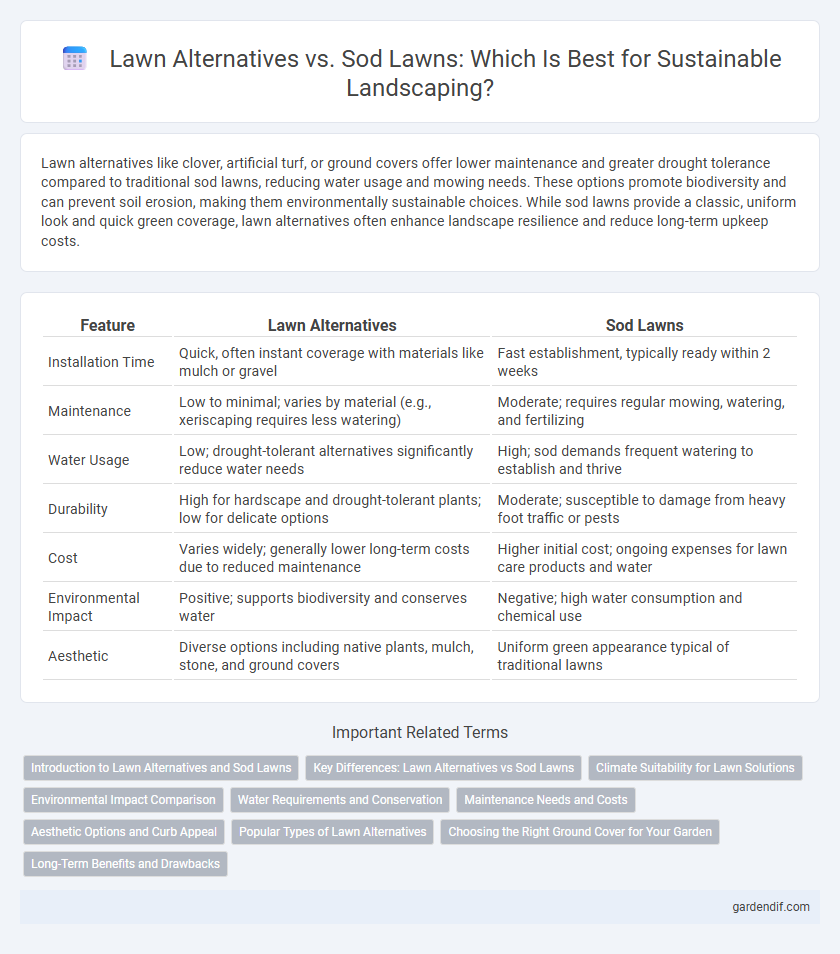
Lawn Alternatives vs Sod Lawns Illustration
Lawn alternatives like clover, artificial turf, or ground covers offer lower maintenance and greater drought tolerance compared to traditional sod lawns, reducing water usage and mowing needs. These options promote biodiversity and can prevent soil erosion, making them environmentally sustainable choices. While sod lawns provide a classic, uniform look and quick green coverage, lawn alternatives often enhance landscape resilience and reduce long-term upkeep costs.
Table of Comparison
| Feature | Lawn Alternatives | Sod Lawns |
|---|---|---|
| Installation Time | Quick, often instant coverage with materials like mulch or gravel | Fast establishment, typically ready within 2 weeks |
| Maintenance | Low to minimal; varies by material (e.g., xeriscaping requires less watering) | Moderate; requires regular mowing, watering, and fertilizing |
| Water Usage | Low; drought-tolerant alternatives significantly reduce water needs | High; sod demands frequent watering to establish and thrive |
| Durability | High for hardscape and drought-tolerant plants; low for delicate options | Moderate; susceptible to damage from heavy foot traffic or pests |
| Cost | Varies widely; generally lower long-term costs due to reduced maintenance | Higher initial cost; ongoing expenses for lawn care products and water |
| Environmental Impact | Positive; supports biodiversity and conserves water | Negative; high water consumption and chemical use |
| Aesthetic | Diverse options including native plants, mulch, stone, and ground covers | Uniform green appearance typical of traditional lawns |
Introduction to Lawn Alternatives and Sod Lawns
Lawn alternatives such as clover, moss, or native groundcovers offer drought-resistant, low-maintenance options that enhance biodiversity and reduce water usage compared to traditional sod lawns. Sod lawns provide instant greenery through pre-grown grass, ensuring uniform coverage and quick installation but often require more frequent watering and mowing. Choosing between lawn alternatives and sod lawns depends on environmental goals, maintenance preferences, and soil conditions.
Key Differences: Lawn Alternatives vs Sod Lawns
Lawn alternatives such as clover, moss, and ornamental grasses offer eco-friendly, low-maintenance options that require less water, fertilizers, and mowing compared to traditional sod lawns. Sod lawns provide a uniform, instantly green surface but demand higher upkeep, regular irrigation, and chemical treatments to stay healthy. Choosing between lawn alternatives and sod lawns depends on factors like environmental impact, maintenance capacity, and desired aesthetic appeal.
Climate Suitability for Lawn Solutions
Lawn alternatives such as native grasses, clover, and drought-tolerant ground covers thrive in arid, Mediterranean, or drought-prone climates where traditional sod lawns often require excessive irrigation and maintenance. Sod lawns, typically consisting of cool-season grasses like Kentucky bluegrass or tall fescue, perform best in temperate regions with consistent rainfall and moderate temperatures. Selecting climate-suitable lawn solutions reduces water consumption, promotes ecosystem resilience, and ensures sustainable landscape management.
Environmental Impact Comparison
Lawn alternatives like native grasses, clover, and groundcovers significantly reduce water consumption and eliminate the need for chemical fertilizers and pesticides compared to traditional sod lawns. These sustainable options enhance soil health, promote biodiversity, and lower carbon emissions by reducing mowing frequency and fuel use. In contrast, sod lawns contribute to higher water usage, chemical runoff, and greenhouse gas emissions, making lawn alternatives a more environmentally responsible landscaping choice.
Water Requirements and Conservation
Lawn alternatives such as native grasses, clover, and drought-tolerant ground covers significantly reduce water consumption compared to traditional sod lawns, which often require irrigation of 1 to 1.5 inches per week. These alternatives improve water conservation by adapting to local climate conditions and minimizing runoff, while sod lawns demand consistent watering schedules to maintain green aesthetics. Selecting drought-resistant plants can lower water usage by up to 50%, supporting sustainable landscaping in arid regions.
Maintenance Needs and Costs
Lawn alternatives such as clover, native grasses, and ground covers typically require significantly less water, mowing, and fertilization compared to traditional sod lawns, reducing ongoing maintenance efforts and expenses. Sod lawns demand frequent mowing, irrigation, and pest control, leading to higher upkeep costs and increased resource use over time. Choosing lawn alternatives can lower annual maintenance costs by up to 50%, making them a cost-effective, eco-friendly option for sustainable landscaping.
Aesthetic Options and Curb Appeal
Lawn alternatives offer diverse aesthetic options such as native grasses, clover, and ornamental plants that enhance curb appeal with varied textures and colors, creating unique landscapes tailored to specific environmental conditions. Sod lawns provide a uniform, lush green carpet that delivers immediate visual impact and traditional beauty but may lack the customization and ecological benefits of alternatives. Choosing between these options depends on balancing instant appeal with long-term visual interest and sustainability goals.
Popular Types of Lawn Alternatives
Popular lawn alternatives include drought-tolerant ground covers such as clover, sedum, and buffalo grass, which require less water and maintenance compared to traditional sod lawns. Native grasses like blue grama and buffalo grass provide resilience and adapt well to local climates, reducing irrigation needs. Artificial turf is another common option, offering a low-maintenance, evergreen surface ideal for high-traffic areas without the need for mowing or fertilizing.
Choosing the Right Ground Cover for Your Garden
Selecting the right ground cover for your garden involves comparing lawn alternatives such as clover, native grasses, or moss with traditional sod lawns. Lawn alternatives often require less water, reduce maintenance, and support biodiversity, making them ideal for sustainable landscaping. Sod lawns provide instant green coverage and uniform aesthetics but demand higher irrigation and fertilizer inputs, influencing long-term care and environmental impact.
Long-Term Benefits and Drawbacks
Lawn alternatives such as native grasses, clover, and groundcovers offer long-term benefits including reduced water usage, lower maintenance costs, and enhanced biodiversity compared to traditional sod lawns. While sod provides an instant green lawn with uniform appearance, it requires frequent watering, fertilization, and mowing, leading to higher environmental impact and ongoing expenses. Choosing lawn alternatives supports sustainable landscaping by improving soil health and resilience to drought, though initial establishment may demand more careful planning and patience.
Lawn Alternatives vs Sod Lawns Infographic

 gardendif.com
gardendif.com